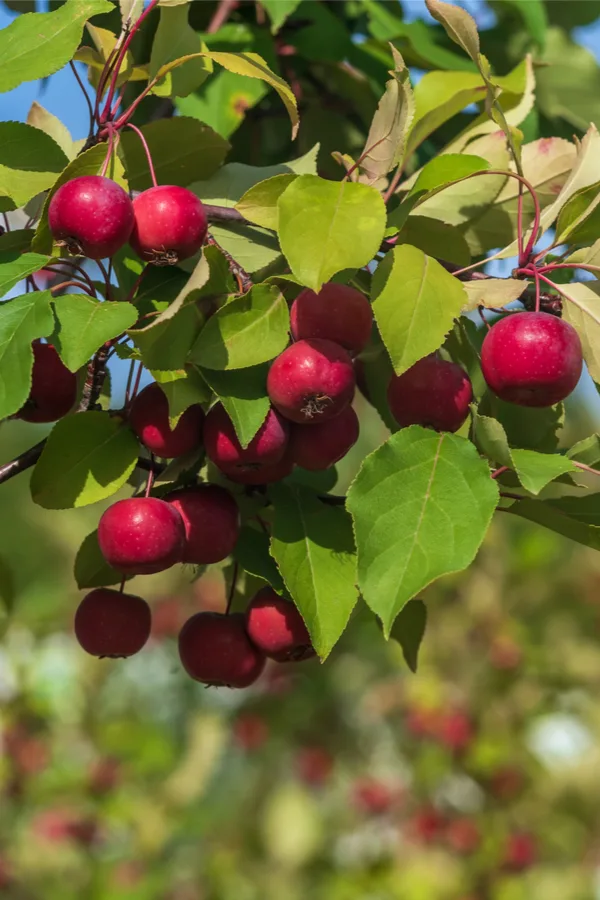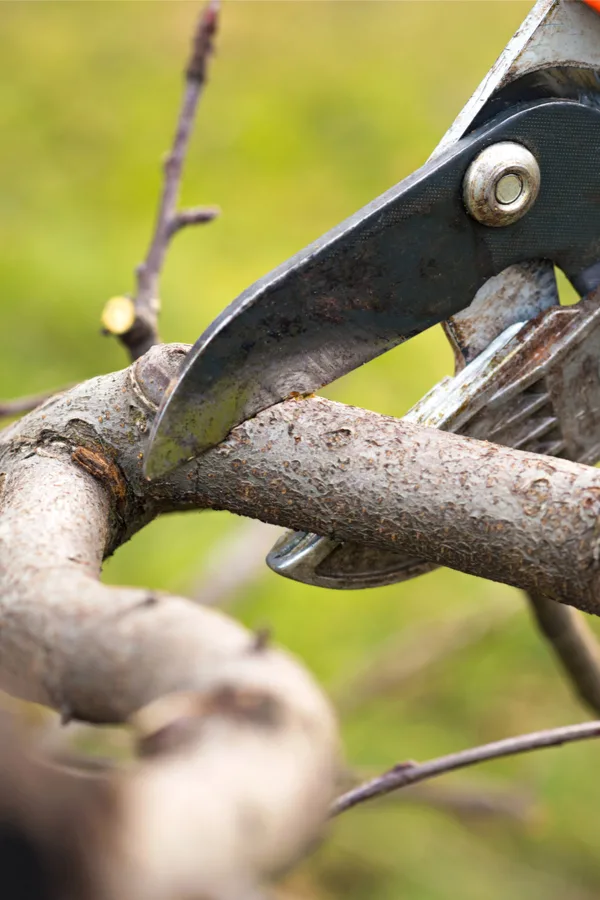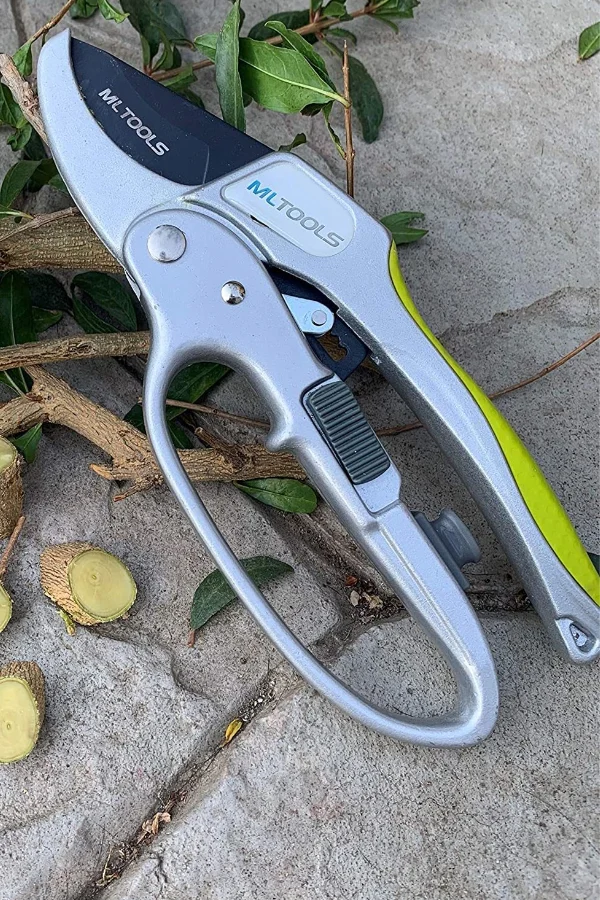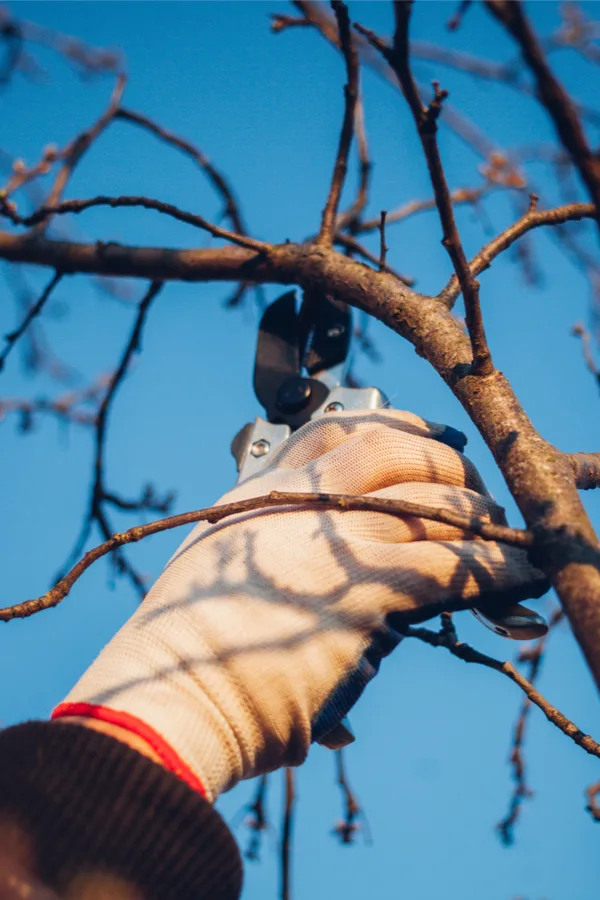When it comes to pruning fruit trees, winter is the ideal time to get your trees in tip top shape. Pruning not only helps create a healthier tree, it also can lead to larger and more plentiful yields.
Pruning fruit trees is not as difficult and scary as many are led to believe. It is, however, an important chore to keep fruit trees healthy and productive. Trees that are left to grow unchecked are not just unsightly, they will also bear less fruit over the years.
Many homeowners are confused by when to prune their fruit trees. For many plants, fall is a great time for cutting back before winter sets in. But for fruit trees, fall pruning should be avoided entirely.

Why is fall bad for trimming back fruit trees? The act of pruning stimulates new growth. And as trees prepare for winter and head into dormancy, new growth can be quite detrimental to their health.
With fall pruning, new growth shoots don’t not have adequate time to harden off before winter’s freezing temperatures settle in. In addition, the cuts from pruning don’t have adequate time to heal either. Both can leave a tree susceptible to the harsh conditions winter can bring.
Why Winter Is The Best Time For Pruning Fruit Trees
Although fruit trees can be pruned in the spring and summer months, pruning in the winter has several advantages. Both for the tree, and the pruner!
For starters, with their leaves gone for the season, branches are easy to see and cut. That is certainly not the case when trying to prune back a full canopy of leaves in spring or summer.

But even more importantly, because fruit trees are dormant in the winter, there is little stress to a tree when it is cut back. In fact, in full dormancy, there is no stress at all. And that allows the tree to conserve and store more energy for flowering and fruiting.
So now that we have established winter as the optimum time for pruning, here is a look at how to go about it this winter to get your trees in shape for big production next year!
Pruning Fruit Trees In The Winter – The Simple Secrets To Success
The Right Tools For The Job
Success with pruning all begins with having the proper tools for the job. For pruning fruit trees, 3 basic tools will do the job well. A pruning saw, a pair of pruning loppers, and a good pair of hand held pruners.
A pruning saw is perfect for removing large limbs and branches quickly. Loppers are good for removing most small to mid size branches up to a few inches in diameter. The hand pruners, meanwhile, are great for easily clearing away small shoots and starts.

As for the loppers and hand held pruners, investing in a ratcheting tool versus traditional pruners can be extremely helpful. These pruners use a gear and ratchet to make pruning thick or tough limbs much easier.
- Product Link : Spear & Jackson Razorsharp Heavy Duty Telescopic Loppers
- Product Link : Garden Guru Ratchet Hand Pruning Shears
Before You Prune…
Always make sure your pruners are sharp before you start cutting. Dull blades will tear limbs, branches and bark, causing both stress and injury to the tree.
Having a clean blade is equally important. The metal blades and teeth on pruners and saws can easily carry disease from tree to tree. Before cutting, wipe down blades with rubbing alcohol, or a 5/1 solution of water and bleach. It is also important to clean the blades from tree to tree.
The Pruning Process – 3 Steps To Success
1) Eliminating damaged and diseased wood
Begin pruning your fruit trees by removing any wood that is dead, diseased or damaged. The last thing you want is a tree spending energy attempting to heal damaged limbs, so your first cuts should concentrate on eliminating any wood that is less than ideal.
When making cuts, always trim back flush to the trunk or branch the limb is coming from. Keeping all cuts flush keeps the tree from having tiny stubs. Not only are they unsightly, they can produce new, unwanted growth.
2) Thinning – How To Prune Fruit Trees In The Winter
Next, it’s time to begin to thin the tree. This is the one pruning task that often causes more angst than any other. The good news is, keeping it simple is the key to success.
For thinning out, think of pruning as opening a blind or window shade for the tree. Trees, much like vegetable plants and flowers, need light and air to survive and thrive. (See : Why Pruning Your Tomato Plants Can Lead To More Tomatoes!)

This is an important step that opens up the tree canopy to let air and light in. By doing this, it allows the fruit to form and ripen better. It also helps to improve the overall health of the tree.
To thin, begin by removing branches that cross each others path. Remove the smallest or least healthy of the two crossing. Repeat this process until the branches within the core of the tree are not touching. This will allow the necessary light needed into the tree.
Next, remove branches with horizontal or downward growth. These branches struggle to hold mature fruit. Branches that grow upwards or at an upwards angle are the best to leave. They naturally hold fruit more securely.
3) Trim Back Last Year’s Growth
The last step is to trim back last year’s growth a bit. This process helps to strengthen the tree, and conserve vital nutrients from being wasted on overgrowth.

When trimming back tree growth, a good rule of thumb is to take off about a quarter (25%) of last year’s growth. This will help to shape the tree into a nice form, and keep it manageable. That is not only good for the tree, but for harvesting as well!
Once you are finished cutting back last year’s growth, all that is left is to pick up the trimmings from around your trees. Cleaning up any branches not only keeps your landscape tidy, it will keep your mowing blades safe and sharp next spring. Here is to pruning your fruit trees this winter!
Follow Our Facebook Page For Great Gardening Tips And Advice! This Is My Garden Facebook Page
This Is My Garden is a garden website created by gardeners, for gardeners. Jim and Mary Competti have been writing gardening, DIY and recipe articles and books and speaking for over 15 years from their 46 acre Ohio farm. They publish three articles every week, 52 weeks a year. Sign up today to follow via email, or follow along!
